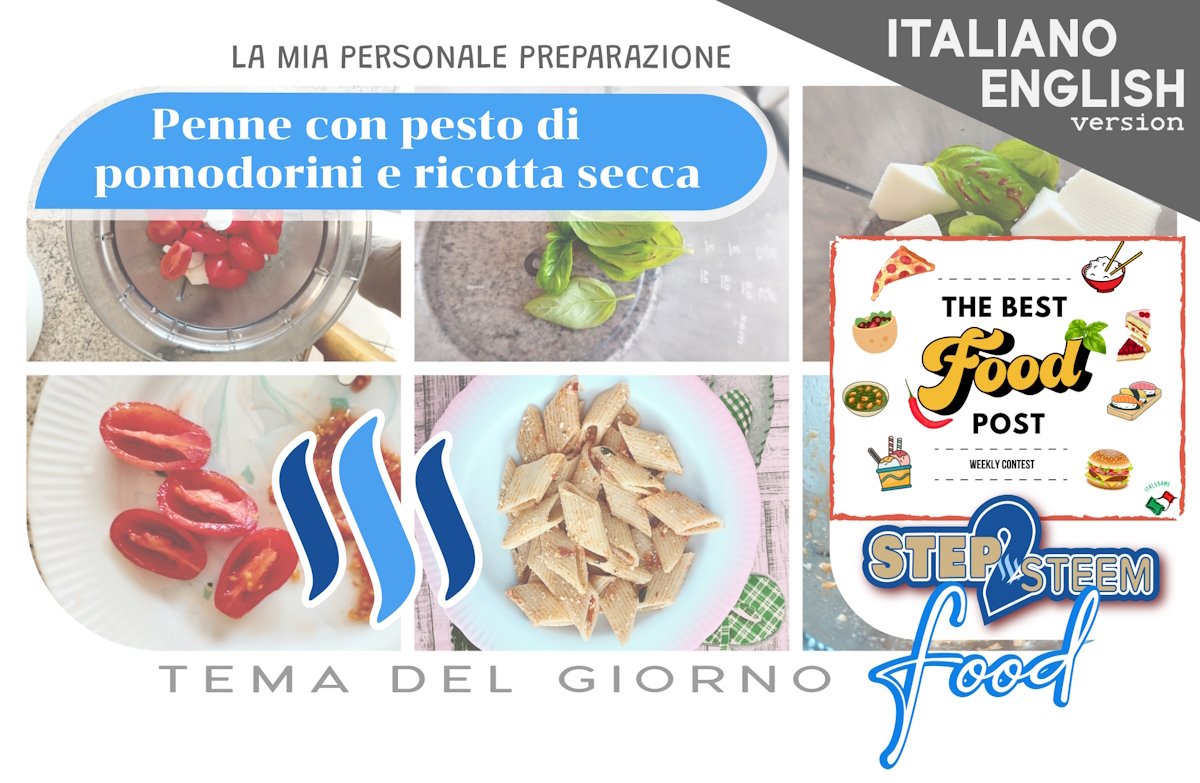You can find the ENGLISH translation after the Italian text.
Tutti gli usi dei contenuti presenti in questo post – e dei loro derivati – sono strettamente proibiti, fatta eccezione la diffusione senza modifiche attraverso canali media e social media.

Ciao!
Dopo un paio di settimane, oggi ho deciso di provare a partecipare al contest lanciato da @italygame nella comunità Italy, il classico THE BEST FOOD POST arrivato alla sua 23esima edizione. Questa settimana ho rispolverato un piatto preparato alcune settimane fa: Penne con pesto di pomodorini e formaggio secco.
Gli INGREDIENTI e l'ATTREZZATURA
Per due persone, le DOSI APPROSSIMATIVE CONSIGLIATE sono:
- Pomodorini, circa 8-10;
- Formaggio secco, circa 80 g;
- Basilico
- Olio extravergine d'oliva
- Acqua
- Penne, 220 g
- Sale
e l'ATTREZZATURA necessaria è:
- Tritatutto o mortaio, con lame o pestello
- Piatti
- Pentola
- Fornello
- Ciotola
- Cucchiaio, forchetta e coltello
- Spatola (non obbligatoria)
La PREPARAZIONE del piatto
Per preparare questa portata, prendiamo gli ingredienti essenziali a realizzare il nostro pesto. Io lo chiamo pesto, e altro non sarebbe che un "battuto", un condimento ottenuto da un metodo preciso. Per "pesto" molti intendono infatti delle famose preparazioni come il Pesto alla genovese, mentre il termine indicherebbe più genericamente una preparazione ottenuta dalla battitura di alcuni ingredienti fino a ottenerne una specie di poltiglia o di cremina. Gli strumenti con cui è possibile ottenere questa preparazione sono i mortai e i pestelli. Nel mio caso, io ho usato un frullatore elettrico, essendo più veloce: il risultato potrebbe avere una grana più grossolana della classica preparazione fatta con mortaio e pestello; nonostante questo, per i miei scopi era più che sufficiente.
Quindi, tornando alla nostra ricetta: prendiamo dei pomodorini e del basilico, andando a pulirli con molta attenzione. Acciuffiamo poi del formaggio secco; nel caso specifico, qualcosa di simile alla Ricotta secca (o salata).

Togliamo la buccia al formaggio e riduciamo la polpa in cubetti adatti a essere inseriti nel frullatore. Torniamo ai pomodorini, rimuovendo i semi che potrebbero causare problemi di mal di pancia o altri disturbi (magari non gravi, ma comunque poco gradevoli).

Inseriamo nel frullatore anche i pomodorini e il basilico. Nel frattempo, riempiamo una pentola di acqua e posizioniamola sul fornello acceso.

Mentre aspettiamo che l'acqua arrivi a bollitura, aggiungiamo un pizzico di sale (ATTENZIONE!) e dell'olio extravergine d'oliva (3-4, a volte anche 5 cucchiai) nel frullatore o nel mortaio, e iniziamo a macinare il tutto. Gli ingredienti andranno a formare una salsa la cui consistenza dovrà essere quella di una crema liquida che inizi a rapprendere. Una nota: non essere di manica larga nell'utilizzo del sale, perché il formaggio secco è spesso molto saporito e persino salato. Ti consiglio di assaggiare il condimento strada facendo, così da evitare di esagerare e ottenere un piatto estremamente sapido.
Quando l'acqua nella pentola arriverà a bollitura, aggiungiamo la pasta e dell'altro sale, lasciando cuocere per il tempo indicato dalla casa produttrice. Se la pasta che cuciniamo è fatta in casa, dovremo ottenere il corretto tempo di cottura con la nostra esperienza. Nel mio caso, io ho utilizzato delle penne che ho lasciato cuocere per circa 13-15 minuti. Una volta pronte, le ho scolate e le ho aggiunte in una scodella in cui avevo già riposto il pesto di pomodorini e formaggio.

Per finire, mescoliamo il tutto e aggiungiamo – nel caso la pasta ci sembri troppo asciutta – un altro poco di olio extravergine d'oliva. Per ammorbidire il condimento, è anche possibile utilizzare una tazzina riempita per metà con l'acqua di cottura della pasta. Infine, impiattiamo.

E anche per questa volta, buon appetito!
FINITO
Una ricetta molto semplice anche per questa settimana. Io ho impiegato qualcosa come 30-40 minuti dall'inizio alla fine, e la facilità della preparazione si adatta bene anche ai non troppo esperti. Molta attenzione – come accennato sopra – va riposta nel dosaggio del sale. Procedere aggiungendolo in più step e sempre con estrema parsimonia sono due consigli che penso utilissimi per chi come me non è un cuoco esperto. Il formaggio secco risults spesso molto salato ed è questo il motivo delle mille raccomandazioni.
E nulla, il post è terminato. Ti saluto e spero che tu abbia ottenuto uno spunto interessante. Mi raccomando: se ti è piaciuto il post, lascia un upvote!
Saluti da me e dall'Italia!

Questo post partecipa al progetto sperimentale Penny4thoughts.
Every use of the contents herein - and/or each derivative - is prohibited without the explicit consent of the author, except for dissemination without modification trough media and social media channels.

Hello!
After a couple of weeks, today I decided to try to participate in the contest launched by @italygame in the Italy community, the classic THE BEST FOOD POST arrived at its 23rd edition. This week I propose a dish prepared a few weeks ago: Penne with tomato and dry cheese seasoning.
The INGREDIENTs and the EQUIPMENTs
For two people, the INGREDIENTS I used are:
- Little tomatoes, about 8-10;
- Savory cheese, about 80 g;
- Basil
- Extra virgin olive oil
- Water
- Penne pasta, 220 g
- Salt
and the EQUIPMENT needed are:
- Blender or mortar, with blades or pestle
- Plates
- Pot
- Stove
- Bowl
- Spoon, fork and knife
- Spatula (not mandatory)
The PREPARATION of the dish
To prepare our main dish, we take the essential ingredients to make our pesto. I call it pesto, and it would be nothing more than a seasoning obtained by a precise method. In fact, by "pesto" many people mean famous preparations such as "Genovese Pesto", while the term would more generally indicate a preparation obtained by beating some ingredients to obtain a kind of mush or creamy sauce. The tools with which (especially in the past) it was possible to obtain this preparation are mortars and pestles. In my case, I used an electric blender, being faster: the result could have a coarser grain than the classic preparation made with a mortar and pestle; despite this, for my purposes, it was acceptable.
So, going back to our recipe: let's take some tomatoes and some basil, cleaning them carefully. Then, grab some dry cheese; in this specific case, something similar to dry (or salty) ricotta.

Let's remove the peel from the cheese and reduce the pulp into cubes suitable for placing in the blender. Let's go back to the cherry tomatoes, removing the seeds that could cause stomach aches or other ailments (perhaps not serious but still unpleasant).

Let's put the cherry tomatoes and basil in the blender too. Meanwhile, fill a pot with water and place it on the stove.

While we're waiting for the water to boil, add a pinch of salt (ATTENTION, PLEASE!) and some extra virgin olive oil (3-4, sometimes even 5 tablespoons) to the blender or mortar, and begin to grind everything. The ingredients will form a sauce whose consistency must be that of a liquid cream that is starting to thicken. One note: don't go overboard with the salt, as dry cheese is often very flavourful and even salty. I suggest you to taste the seasoning along the way, so as to avoid overdoing it and obtain an extremely savoury dish.
When the water in the pot comes to a boil, add the pasta and salt, leaving it to cook for the time indicated by the manufacturer. If the pasta we cook is homemade, we will have to get the right cooking time with our experience. In my case, I used penne which I let cook for about 13-15 minutes. Once ready, I drained and added them to a bowl in which I had already placed the cherry tomato and cheese pesto.

Finally, mix everything together and add – if the pasta seems too dry – a little more extra virgin olive oil. To soften the seasoning, you can use a cup half filled with the pasta cooking water. Finally, let's serve.

And even this time, enjoy the meal!
COMPLETED
A very simple recipe for this week too. It took me something like 30-40 minutes from the start to the finish line, and the ease of preparation is also well suited to inexperienced cooks. Much attention – as mentioned above – must be placed on the dosage of salt. Proceed by adding it in several steps and always with extreme parsimony are two tips that I think are very useful for those like me who are not expert cooks. Dry cheese is often very salty, and this is the reason for the thousand recommendations I left you.
And nothing more, the post reached the end. I greet you and I hope you're obtaining an interesting suggestion. I recommend: if you liked the post, leave an upvote! ;)
Greetings from me and from Italy!

This post join the Penny4thoughts experimental project.

